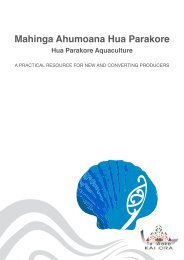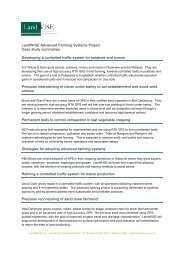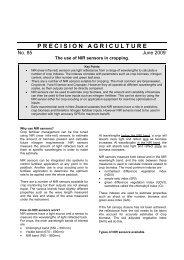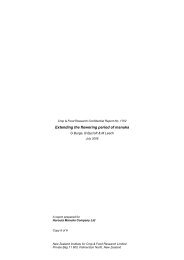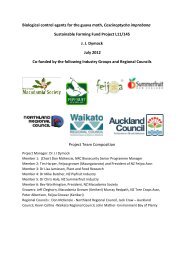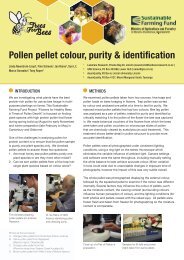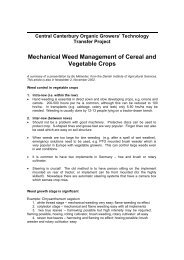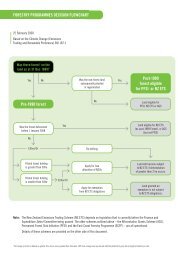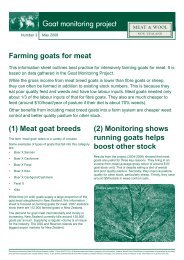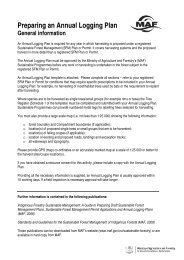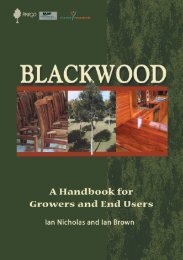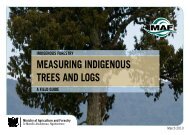Chapter 5: Management (mowing and mulching) [871K PDF]
Chapter 5: Management (mowing and mulching) [871K PDF]
Chapter 5: Management (mowing and mulching) [871K PDF]
You also want an ePaper? Increase the reach of your titles
YUMPU automatically turns print PDFs into web optimized ePapers that Google loves.
Farm <strong>Management</strong> of Kikuyu for<br />
Production <strong>and</strong> Profit<br />
Northl<strong>and</strong> Kikuyu<br />
Action Group<br />
5<br />
The role of <strong>mulching</strong><br />
This is a summary of the results of trial work<br />
carried out to date by Wayne Andrewes for the<br />
Northl<strong>and</strong> Kikuyu Action Group on options for<br />
management of kikuyu grass to maximise farm<br />
production.<br />
Kikuyu grass is a subtropical grass wellestablished<br />
throughout Northl<strong>and</strong> <strong>and</strong> is moving<br />
southwards to other warm regions. Around 40%<br />
of Northl<strong>and</strong> pastures are now kikuyu-dominant,<br />
which means that in summer <strong>and</strong> autumn vigorous<br />
kikuyu growth can suppress other pasture plants<br />
such as ryegrass <strong>and</strong> clover, resulting in low<br />
nutritive value of pasture in winter <strong>and</strong> spring. In<br />
colder weather in winter <strong>and</strong> spring kikuyu has<br />
very low growth rates, which means it contributes<br />
very little towards livestock feeding.<br />
Kikuyu is a controversial plant. Love it or hate<br />
it, once established kikuyu has to be carefully<br />
managed to achieve maximum production.<br />
A kikuyu pasture is a complex of plants of different<br />
ages <strong>and</strong> maturity. Old plants are droughtresilient<br />
<strong>and</strong> able to withst<strong>and</strong> insect attack.<br />
Other benefits include lower facial eczema risk<br />
to grazing livestock. The fast rate of growth in<br />
January <strong>and</strong> February means that livestock can<br />
actually produce better on kikuyu than ryegrass<br />
during that period, providing kikuyu pasture is<br />
well-managed for leaf <strong>and</strong> stem growth.<br />
Kikuyu is an extremely competitive pasture plant<br />
throughout Northl<strong>and</strong>. It is easy to see how it<br />
dominates other species by growing over the<br />
top, <strong>and</strong> shading them.<br />
What is not so obvious is the extent of its root<br />
system. The combination of a dense stoloniferous<br />
mat above the ground <strong>and</strong> the distribution of<br />
large rhizomes with extensive fibrous roots is one<br />
reason kikuyu is twice as efficient as ryegrass in<br />
utilizing rainfall; another is that it is a C4 grass<br />
with a different metabolism to ryegrass.<br />
Kikuyu Action Group<br />
The Northl<strong>and</strong> Kikuyu Action Group (KAG) of<br />
farmers, advisors <strong>and</strong> researchers, formed in<br />
1999, has conducted trials <strong>and</strong> commissioned<br />
research to provide a “tool box” of options for<br />
farmers to improve the management of kikuyudominant<br />
pasture, <strong>and</strong> improve results, according<br />
to their farm policies <strong>and</strong> circumstances.<br />
One recommendation currently in the toolbox is<br />
<strong>mulching</strong>. This is the control achieved over kikuyu<br />
in late summer <strong>and</strong> early autumn by <strong>mulching</strong><br />
machines so that annual or permanent ryegrass<br />
can be sown into a kikuyu dominant pasture to<br />
provide for winter <strong>and</strong> spring production. A key<br />
objective is to increase the quality of pasture<br />
(metabolisable energy, ME) during winter <strong>and</strong><br />
spring, when kikuyu itself is not productive.<br />
Work is also continuing into the best methods of<br />
kikuyu eradication where economics <strong>and</strong> farm<br />
terrain permit. It is recognised that eradication of<br />
kikuyu is not practical for all Northl<strong>and</strong> farmers<br />
for a variety of reasons, including slope <strong>and</strong><br />
cost. Also, a project focussing on management<br />
options for sheep <strong>and</strong> beef farmers, including the<br />
role of the breeding cow in kikuyu management,<br />
is underway. KAG considers that farmers need<br />
that “toolbox” of management options to make<br />
the best use of their kikuyu resource.
Kikuyu pasture growth <strong>and</strong> quality, vs ryegrass<br />
Kikuyu grows leaf, stem <strong>and</strong> stolons above the<br />
ground <strong>and</strong> rhizomes below. Roots emerge<br />
from the stolons <strong>and</strong> another “plant” can readily<br />
establish from a piece of cut stolon. It is an<br />
aggressive coloniser, with stolons moving 25mm<br />
a day in the right conditions. Below the ground,<br />
rhizomes are also moving outwards.<br />
To underst<strong>and</strong> kikuyu management, farmers must<br />
put aside what they currently accept as best<br />
practice for ryegrass management. Temperate<br />
ryegrass grows from tillers throughout the year,<br />
it is weakest in a drought, susceptible to insect<br />
attack <strong>and</strong> harbours the spores which cause facial<br />
eczema in livestock.<br />
Ryegrass quality does not change as much during<br />
the year, in comparison to kikuyu, even during<br />
the seed production phase. Farmers can make<br />
good quality hay from seeded ryegrass. Ryegrass<br />
can be put onto a long rotation in autumn without<br />
losing quality, but kikuyu cannot.<br />
The stark contrast between ryegrass <strong>and</strong> kikuyu<br />
root systems.<br />
For ryegrass the emphasis of feed availability is<br />
on producing more dry matter, or the quantity of<br />
feed grown. By comparison, because the value<br />
of kikuyu for farmers varies widely during its<br />
growth phases, to maximise production from a<br />
kikuyu-dominant pasture a farmer must underst<strong>and</strong><br />
how to manage quality. Keeping kikuyu in a leafy<br />
growing state to maximise quality is far more<br />
important than managing it for extra dry matter<br />
yield. Kikuyu declines in quality as it accumulates<br />
more dry matter. The faster it grows the quicker<br />
it loses quality. On farms with low stocking rates<br />
(<strong>and</strong> the Northl<strong>and</strong> dairy farm average is only<br />
2.2 cows/ha) old kikuyu needs to be mulched.<br />
Forcing stock to eat old kikuyu will cause losses in<br />
condition <strong>and</strong> live weight.<br />
Rather than assessing a kikuyu-dominant pasture<br />
in terms of kg DM/ha (which will over-estimate<br />
the potential production off the pasture), it is more<br />
useful to use the pasture quality, as measured by<br />
ME – or metabolisable energy.<br />
An underst<strong>and</strong>ing of the changing yield <strong>and</strong><br />
pasture quality of kikuyu leaf, stem <strong>and</strong> stolon is<br />
vital to maximising production from kikuyu. Figure<br />
1 shows changes in yield <strong>and</strong> quality of kikuyu<br />
grass during late summer in Northl<strong>and</strong>.<br />
Yield (kg DM/ha)<br />
Figure 1 : Yield <strong>and</strong> pasture quality of Kikuyu leaf, stem <strong>and</strong> stolon in<br />
summer, during a period of rapid growth<br />
5000<br />
Quality in<br />
4000 Leaf<br />
MJME/kg DM<br />
Stem/Stolon<br />
Leaf 9-10<br />
3000<br />
Leaf 9-11<br />
2000<br />
1000<br />
0<br />
Leaf<br />
10-11<br />
Stem 9-10<br />
Stem 8-9<br />
2 weeks 4 weeks 6 weeks<br />
Rotation Length<br />
Stem 7-9<br />
When properly managed, kikuyu adds to pasture<br />
productivity in January <strong>and</strong> February. It has a high<br />
leaf-to-stem ratio, <strong>and</strong> young leaf <strong>and</strong> stem has<br />
good levels of metabolisable energy from 10 to<br />
11MJ ME/kgDM (mega joules of metabolisable<br />
energy per kilogram of dry matter). Kikuyu over<br />
four weeks of age is “old” - especially when the<br />
sward is growing rapidly. By six weeks the leaf will<br />
be just 9 to 10MJ ME which is barely productive<br />
for milk or growth. By this time the stem is around<br />
8MJ ME <strong>and</strong> cattle will only eat the leaf. Because<br />
kikuyu fi bre takes longer to digest, kikuyu stem of<br />
this age is less valuable than hay, so for cattle it is<br />
barely maintenance feed. Old stolon is only 7MJ<br />
ME, has poor digestibility <strong>and</strong> its overall nutritive<br />
value is so poor that cattle forced to eat it will<br />
lose weight. This is the reason mechanical control<br />
of kikuyu is recommended, rather than grazing<br />
control.<br />
In December <strong>and</strong> January kikuyu produces a<br />
high ratio of leaf-to-stem/stolon (70:30). This<br />
ratio declines during the season <strong>and</strong> can reverse<br />
(30:70) in autumn. Based on farmer experience,<br />
best milk production is from fast-growing green<br />
leaf (10-11MJ ME/kgDM). Stem/stolon can be<br />
milked off only when it is green <strong>and</strong> growing (>9-<br />
10MJ ME). Quality declines rapidly in the stem/<br />
stolon after two to three weeks of growth (8-9MJ<br />
ME). When kikuyu is on a long rotation the feed
quality of the stolon is as low as 7MJ ME. Cattle<br />
may not maintain themselves on this low quality<br />
feed, <strong>and</strong> will lose weight no matter how much<br />
kikuyu they eat. As kikuyu ages it lays down more<br />
fi bre which is diffi cult for cows to digest. It may<br />
take as long as three weeks for kikuyu stolon to<br />
pass through the rumen, compared with one week<br />
for ryegrass. This may lead to kikuyu impaction,<br />
which is life-threatening to the animal.<br />
Poor pasture utilisation<br />
Because Kikuyu is stoloniferous it is more complex<br />
than ryegrass. The tip of the stolon will have young<br />
leaves with high ME value but further down the<br />
stolon the leaves are older <strong>and</strong> of lower ME. If<br />
a farmer is on a 21-day rotation <strong>and</strong> the cows<br />
do not eat all the kikuyu on the next grazing,<br />
the unutilised parts are six weeks old <strong>and</strong> only<br />
the newly grown leaf is productive at the next<br />
grazing. This is how a mat develops, because the<br />
cows leave the older leaves at each grazing. That<br />
mat must be attacked, preferably by mechanical<br />
means, if the quality of the pastures is to be<br />
recovered. Otherwise over time the kikuyu mat<br />
will reach the depth of gumboots <strong>and</strong> climb the<br />
fences <strong>and</strong> the soil underneath will become sour<br />
<strong>and</strong> unproductive. Without intervention, that old<br />
kikuyu mat is a very poor environment in which<br />
to attempt annual ryegrass establishment. It is<br />
essential to avoid a build-up of old summer kikuyu<br />
<strong>and</strong> to get rid of kikuyu trash before sowing.<br />
Paddocks that remain kikuyu-dominant in winter<br />
may grow as little as 0-10 kg DM/ha/day winter,<br />
compared to ryegrass swards which will grow 15-<br />
25 kg DM/ha/day under the same conditions.<br />
Although growth will improve in spring, there will<br />
be a decline around late October/<br />
November as the annuals, such<br />
as poa, that grow after kikuyu<br />
dominance, fl ower <strong>and</strong> die back.<br />
Relative to ryegrass the period of<br />
poor growth will last to December.<br />
This will reduce the feed supply<br />
required to ensure cows breed well<br />
<strong>and</strong> achieve peak milk production.<br />
It is one reason why modern, later<br />
fl owering annuals or perennials<br />
are recommended as these grow<br />
through until January, when kikuyu takes over for<br />
its summer duties.<br />
Kikuyu pasture management<br />
Kikuyu Action Group (KAG) trials were carried<br />
out by an independent science provider on highfertility,<br />
fl at l<strong>and</strong> dairy farms. Trials were based on<br />
large plots within paddocks subjected to normal<br />
dairy grazing management. Results were obtained<br />
from farms near Whangarei, Dargaville, Kerikeri<br />
<strong>and</strong> Kaitaia.<br />
The trials compared different methods of<br />
controlling vigorous kikuyu in the late summer <strong>and</strong><br />
early autumn, followed by sowing of annuals to<br />
boost winter <strong>and</strong> spring pasture production.<br />
KAG has had the satisfaction of seeing a huge<br />
increase in productivity on farms where wholefarm<br />
kikuyu <strong>mulching</strong> has been adopted. Two<br />
farm examples of the positive changes in milk<br />
production <strong>and</strong> cow numbers using <strong>mulching</strong> <strong>and</strong><br />
annuals are given below.<br />
J Gluckman & J Vivian 50:50 Warkworth 85%<br />
Kikuyu dominant<br />
The Rodney District average ranged from 470<br />
to 594 kg MS/ha during these seasons.<br />
All kikuyu pasture was mulched once or twice a<br />
year. Annuals sown in April.<br />
Friesian-x calving late July. Some cows, all<br />
young stock grazing off. 80-100 kg N/ha<br />
Supplements fed: baleage <strong>and</strong> hay. Farm has<br />
high fertility 35-45 Olsen P.<br />
Contour: 80% rolling-steep hills. Warkworth<br />
clay 20% alluvial fl ats<br />
Season Kg MS Cows ha Kg MS/ha<br />
04/05 72,000 230 95 720 Mulch + Annuals<br />
03/04 58,500 230 90 650 Mulch + Annuals<br />
02/03 60,741 210 90 674 Mulch + Annuals<br />
01/02 53,400 190 83 643 Mulch<br />
00/01 51,000 190 83 614 Mulch<br />
99/00 41,300 190 85 486 No mulch<br />
98/99 37,313 190 85 439 No mulch<br />
Maximum improvement<br />
281 kg MS/ha
Murray Jagger <strong>mulching</strong> on his Whangarei Heads<br />
dairy farm.<br />
A similar trend was shown on Murray Jagger’s<br />
Whangarei Heads property, where all his kikuyu<br />
is mulched two or three times a year, annuals are<br />
sown in April <strong>and</strong> his production has been built up<br />
to 738 kgMS/ha compared with the Whangarei<br />
district average of 550-614 kgMS/ha. However,<br />
this situation was compounded by taking over a<br />
lease of 53 ha of low fertility rank kikuyu – <strong>and</strong><br />
highlights the impact this had on his whole farm<br />
production.<br />
Mulching versus <strong>mowing</strong><br />
Until the availability of PTO mulchers, Northl<strong>and</strong><br />
farmers’ options for control or eradication of<br />
kikuyu were limited to use of stock pressure <strong>and</strong><br />
<strong>mowing</strong> or topping. A mower can be used to<br />
control kikuyu, especially if cut before a mat<br />
develops. Mowers are faster over the ground<br />
take less horsepower to drive than the modern<br />
mulchers. But the trash from a mower does not<br />
break down as quickly as that from a mulcher<br />
when old kikuyu is cut. The combination of kikuyu<br />
stolons <strong>and</strong> rhizomes means that topping above<br />
3 cm has very little effect on kikuyu. Mulching<br />
or (if a mower can be set low enough) <strong>mowing</strong><br />
close to ground level has a big impact on stolons<br />
<strong>and</strong> causes kikuyu to draw on root reserves.<br />
Mulching during the period when kikuyu growth<br />
is slowing down due to cooler soil temperatures in<br />
autumn weakens kikuyu’s competitive advantage<br />
<strong>and</strong> ability to winter leaving an opportunity for<br />
ryegrass production.<br />
The most important use of a mulcher on a kikyuyudominant<br />
farm is in autumn when annual ryegrass<br />
or any other seed is being drilled into kikuyu<br />
which is then mulched close to ground level (1 to<br />
2 cm). For the rest of the year a mower can control<br />
kikuyu, unless kikuyu has been allowed to get out<br />
of control. Then a mulcher has the advantage of<br />
chopping up kikuyu so it will break down more<br />
rapidly than the long lengths left behind after<br />
<strong>mowing</strong>.<br />
A mulcher has around 20 offset blades mounted<br />
on a horizontally rotating drum. Individual blades<br />
are swinging <strong>and</strong> cutting vertically, compared to<br />
the horizontal motion of mower blades. Using a<br />
hydraulic top link, <strong>and</strong> adjusting the height of the<br />
drums means many mulchers can be set so the<br />
blades cut to ground level.<br />
Kikuyu grows horizontally mainly via stolons.<br />
A vertical cutting action does more damage to<br />
stolons than the horizontal action of a mower.<br />
It is very important to clean up a paddock before<br />
<strong>mulching</strong> it <strong>and</strong> to avoid risk areas where things<br />
like water pipes, wire <strong>and</strong> old stumps or trunks<br />
may be buried under the kikuyu.<br />
A guide to the height of pasture remaining after<br />
<strong>mulching</strong>.
Wide mulchers (2.4 m) are appropriate on fl at<br />
l<strong>and</strong>. A wide mulcher covers more l<strong>and</strong> on each<br />
pass <strong>and</strong> therefore, provided the tractor has 100<br />
to 120 HP to drive it, is faster than a narrow<br />
mulcher. The more undulating the l<strong>and</strong> the better<br />
it is to use a narrower (1.8 m) mulcher, especially<br />
with a 80 HP tractor, fi rst time around the farm.<br />
Overall on rolling hill country 2.2 m is a good<br />
compromise between speed <strong>and</strong> undulations <strong>and</strong><br />
2.4 m is the maximum. An adjustable roller <strong>and</strong><br />
hydraulic top link are important for controlling the<br />
ground height of the mulcher.<br />
Mulching at the ideal height.<br />
There are a range of factors that will change the<br />
cutting height as conditions change. For example,<br />
after rain the mulcher skids will sink into the soil<br />
more than on hard ground. If the mulcher was set<br />
to cut low in dry conditions it may cut too low<br />
when the soil is wet (aim for a target of no more<br />
than 15% scalping), or conversely, if set low for<br />
wet conditions, will cut too high in dry conditions.<br />
A solid mat of kikuyu will cause the mulcher to cut<br />
higher as the skids ride over the mat.<br />
As a guide the height of the pasture remaining<br />
after <strong>mulching</strong>, this should be to the height of the<br />
clicker on a ball point pen. It is important to check<br />
the height setting on a mulcher as soon as you<br />
commence <strong>mulching</strong>.<br />
Mulching kikuyu close to ground level achieves<br />
two important objectives.<br />
1. Kikuyu stolons <strong>and</strong> some rhizomes are cut.<br />
This weakens kikuyu’s ability to dominate other<br />
species, because the stolons are the main sources<br />
of energy for regrowth.<br />
2. Mulching causes kikuyu trash to rot more<br />
quickly than <strong>mowing</strong>, because it is cut fi nely,<br />
<strong>and</strong> evenly distributed. A rear stabilising bar is<br />
a disadvantage because it collects trash. The<br />
mulcher must be able to cut to ground level. Many<br />
cannot.<br />
It is essential that <strong>mulching</strong> <strong>and</strong> <strong>mowing</strong> is carried<br />
out every year, whenever old stolon shades out<br />
white clover <strong>and</strong> ryegrass.<br />
Autumn kikuyu management begins in February<br />
when summer rain <strong>and</strong> warm humid conditions<br />
promote kikuyu growth. Mulching or <strong>mowing</strong><br />
must commence before a mat develops in the<br />
paddocks that are targeted for sowing with<br />
ryegrass.<br />
Mulching close to ground level is important<br />
when sowing seed. This reduces competition by<br />
restricting the regrowth of kikuyu. If kikuyu has<br />
been sprayed with glyphosate, <strong>mulching</strong> breaks<br />
down the dry matter <strong>and</strong> brings the sprayed dry<br />
matter into contact with the soil, where gyphosate<br />
can be denatured. It is easy to establish annuals<br />
into well-managed leafy kikuyu without a mat.<br />
April is the best month in the mid North, <strong>and</strong> late<br />
April to mid May in the Far North. The best <strong>and</strong><br />
most consistent results to establish ryegrass have<br />
been to graze kikuyu (provided a summer mat has<br />
not developed), then drill with 22 kg/ha of a late<br />
fl owering ryegrass followed by <strong>mulching</strong> close to<br />
ground level.
Broadcast or drill?<br />
In KAG research, broadcasting of annual ryegrass<br />
seed gave similar results to drilling when kikuyu<br />
was mulched close to ground level during a<br />
period of moist soil conditions which were good<br />
for establishment. However drilling was more<br />
reliable over all, especially under dry conditions,<br />
<strong>and</strong> when there is more competition or residual<br />
kikuyu trash. Most failure to establish ryegrass is<br />
caused by the failure to remove trash, whether<br />
sprayed with glyphosate or not. This is especially<br />
associated with dung patches.<br />
Successful sowing of annual ryegrass in a kikuyudominant<br />
paddock.<br />
Is sowing annuals <strong>and</strong> <strong>mulching</strong> profitable?<br />
KAG trial work shows there has been a production<br />
increase of over 200 kg/ha on four kikuyudominant<br />
dairy farms which have mulched <strong>and</strong><br />
sown annuals.<br />
Cost-benefit analysis<br />
Income at a $4.00 payout x 200kg MS/ha<br />
average increase = $800 per ha<br />
Costs 2 <strong>mulching</strong>s at $110/ha $220/ha<br />
Drill at $80/ha $80/ha<br />
Annual ryegrass 22 kg/ha at $6/kg $132/ha<br />
Total costs = $432 per ha<br />
Profit = $368 per ha<br />
Note that the machinery cost above has been<br />
calculated as if contractors were used. For<br />
farmers who already have their own machinery<br />
<strong>and</strong> use it for other purposes the cost is less.<br />
Note also that where kikuyu dominance is<br />
70% or more of the effective pasture area the<br />
additional profi t is actually gained over the<br />
whole effective area.<br />
Patchy results in winter ryegrass after kikuyu<br />
renovation trials on Jagger farms.<br />
Controlling kikuyu using glyphosate<br />
Spraying 1 to 3 litres of glyphosate/ha as a<br />
means of control when kikuyu growth is rampant<br />
is a new way of looking at kikuyu management.<br />
It works on the same principle as closing up for<br />
silage in spring, when pasture growth exceeds<br />
dem<strong>and</strong> spraying out will reduce effective pasture<br />
area therefore increase grazing pressure (<strong>and</strong><br />
control) on the unsprayed kikuyu areas of the<br />
farm. This approach will benefi t pasture quality<br />
in areas that are not sprayed. Consider spraying<br />
a paddock out in late February <strong>and</strong> then review<br />
whether more paddocks need to be spray out<br />
in March. However, note that the label rate of<br />
glyphosate is 6 litres/ha, so farmers use lighter<br />
rates at their own risk.<br />
Some farmers do not want to kill kikuyu. They want<br />
it to produce the next summer after an autumn
spray. Rates of 750 mls/ha to 1 litre achieve<br />
a reliable brown-out <strong>and</strong> kikuyu will regrow the<br />
following summer. Rates of 1.5 litres/ha to 3<br />
litres/ha will achieve a signifi cant kill <strong>and</strong> suppress<br />
kikuyu for up to two years. Even at 6 litres/ha<br />
there is signifi cant regrowth of kikuyu in two years<br />
following a single autumn spray, however 6 litres<br />
does have a greater kill than lower rates. High<br />
rates of glyphosate are recommended when<br />
undertaking a cropping/regrassing programme.<br />
A glasshouse experiment showed that it was<br />
possible for a residual effect from sprayed kikuyu<br />
to reduce the germination <strong>and</strong> growth of young<br />
ryegrass seeds <strong>and</strong> seedlings when kikuyu was<br />
sprayed with 6 litres/ha of Round-up Renew but<br />
not at 3 litres or 1.5 litres/ha.<br />
For a longer-lasting effect on kikuyu, use a high<br />
rate of glyphosate, but don’t sow ryegrass seed<br />
until the residual kikuyu trash has been removed.<br />
How much kikuyu pasture should be renovated?<br />
Between the end of February <strong>and</strong> mid-March,<br />
assess the whole farm looking for the worst<br />
paddocks, those with high kikuyu dominance <strong>and</strong><br />
low ryegrass content. Avoid spraying paddocks<br />
that fl ood or are too wet to graze on a regular<br />
basis in winter <strong>and</strong> spring. Do a feed budget to<br />
determine the area you can afford to spray:<br />
If the leaf-to-stem/stolon ratio is 50%, a growth<br />
rate of 50kg DM/ha/day should be valued at<br />
only 25kgDM/ha/day for milking purposes.<br />
Saved/rank kikuyu will lose quality <strong>and</strong> is better<br />
removed by spraying then <strong>mowing</strong> or <strong>mulching</strong> to<br />
ground level.<br />
Removal of sprayed kikuyu trash is essential or new<br />
grass establishment will be reduced. Mulchers<br />
are better than mowers if there is signifi cant trash.<br />
Both must be set to cut to ground level.<br />
The sprayed area is taken out of grazing for at least<br />
two to three months. Consider splitting the area<br />
for spraying into two. For example, half around<br />
mid March <strong>and</strong> half in early April in case rapid<br />
kikuyu growth stops due to dry or cold weather.<br />
Any paddocks to be cropped are included in the<br />
total area taken out of grazing.<br />
Wayne Andrewes addressing farmers on <strong>mulching</strong> techniques
Common mistakes<br />
The biggest mistake is allowing a summer kikuyu<br />
mat to build up <strong>and</strong> then failing to remove it<br />
before sowing seed. The next big mistake is not<br />
sowing annual ryegrass by the end of April.<br />
This is caused by failing to start early. Mowing<br />
or <strong>mulching</strong> kikuyu should begin in February, at<br />
one paddock per day. You can always stop if a<br />
dry spell continues. If you don’t do this a mat<br />
develops. If so, mulch two paddocks a day in<br />
March, especially the worst paddocks.<br />
The usual reason farmers don’t start early is<br />
because of concern that the farm will run out of<br />
feed. If summer kikuyu is not mown or mulched<br />
cattle only browse the leaf. The stem <strong>and</strong> stolon<br />
continue to grow <strong>and</strong> by April the feed quality<br />
of kikuyu will have dropped. There may be<br />
3,000 kg DM/ha st<strong>and</strong>ing but only 1,000 kg of<br />
this will be better than maintenance. The rest is<br />
sub-maintenance. Cows will dry themselves off.<br />
When old kikuyu is mulched it does not break<br />
down easily. The success of sowing seed is cut<br />
by at least half. It takes time to mulch a 100 ha<br />
farm so if <strong>mulching</strong> starts on April 1 it has to<br />
continue into May. This is too late to get an early<br />
winter benefit from the annual seed sown. April<br />
has proven to be the best month for establishing<br />
seed in unsprayed kikuyu in the mid North <strong>and</strong><br />
late April to late May in the Far North.<br />
Summary<br />
Kikuyu management priority on-farm boils down<br />
to this:<br />
• Keep kikuyu leafy <strong>and</strong> do not allow stolon<br />
or stem to over-develop.<br />
• Avoid kikuyu shading out other productive<br />
pasture species.<br />
• A well-managed kikuyu-dominant pasture<br />
has a good content of white clover.<br />
• Control summer <strong>and</strong> autumn kikuyu<br />
dominance – do not allow a mat of old<br />
kikuyu to develop.<br />
• Drill late-fl owering annuals at 20kg/ha in<br />
April/early May, to carry grass<br />
production into January, when the kikuyu<br />
takes over.<br />
• Mulch to ground level. A mulcher cuts<br />
vertically <strong>and</strong> therefore does more<br />
damage to kikuyu stolons than a mower,<br />
which cuts horizontally.<br />
Acknowledgements<br />
Thanks to all the farmers who contributed their time, l<strong>and</strong>,<br />
stock <strong>and</strong> machinery. To Northl<strong>and</strong> Seed <strong>and</strong> Supplies; D<br />
Boyt Machinery; RD1; Ballance Agri-Nutrients; Dexcel,<br />
AgResearch, PGG Wrightson Seeds <strong>and</strong> NuFarm. To Murray<br />
Jagger <strong>and</strong> all the other farmer members <strong>and</strong> non-farmers of<br />
KAG who have given their time <strong>and</strong> enthusiasm to attend KAG<br />
meetings. To the NZ L<strong>and</strong>care Trust for project management<br />
<strong>and</strong> continuity. To the funders who made the work possible:<br />
AGMARDT, Sustainable Farming Fund, FITT fund, NRC,<br />
Northl<strong>and</strong> Agricultural Field Days Committee, <strong>and</strong> C. Alma<br />
Baker. Especially to Hinerangi Trust without whose initial<br />
support back in 1999 work would not have started.


![Chapter 5: Management (mowing and mulching) [871K PDF]](https://img.yumpu.com/30448516/1/500x640/chapter-5-management-mowing-and-mulching-871k-pdf.jpg)
